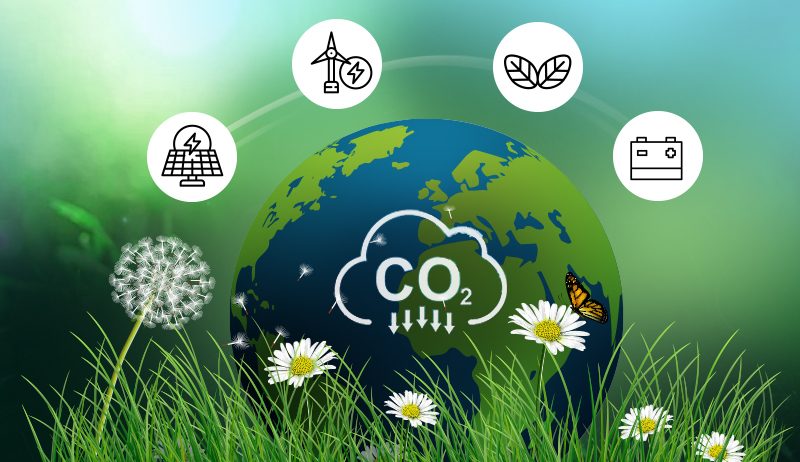The amount of carbon your home produces can greatly influence how efficiently you use energy at home.
Are you aware of the impact your emissions have on the environment and climate change? Many people are not.
Taking steps to decrease your CO2 emissions is a responsible way to manage your consumption habits.
Even small efforts can make a difference in reducing your carbon emissions. That’s why we are here today with the 10 most effective ways to reduce your carbon footprint as a homeowner.
It is the ultimate guide to reducing your household’s carbon footprint. It is for Homeowners who wish to become more conscious to minimize their environmental impact.
Overview of Our Carbon Footprint
Increasing emissions is a big problem for our planet. Did you know that the things you do every day can affect the climate and make global warming worse?
You might be doing things that are bad for the environment or making more emissions without knowing it.
Your lifestyle, what you buy, how you use energy and other things can all impact the amount of carbon you produce.
Data from the World Bank shows that, on average, each person in Australia produces about 15 tonnes of a gas called CO2 every year.
This is a lot compared to the rest of the world, about three times more than what people globally produce on average.
Climate Analytics, warns that if Australia continues like this, it could become one of the biggest sources of pollution in the world, causing up to 17% of the world’s pollution by 2030.
Australian homes contribute a big part to this problem, making up one-fifth of the pollution caused by the whole country.
The United Nations says that if we don’t reduce the amount of CO2 we produce, the world won’t be able to achieve the goal set in the Paris Agreement.
This goal is to limit the increase in the Earth’s temperature to only 1.5 degrees Celsius. The UN warns that countries, like Australia, need to bring down the amount of CO2 each person produces to 2-2.5 tonnes per year by 2030.
To understand better, let’s look at some basics-
What is A Carbon Footprint?
A carbon footprint is the total amount of greenhouse gases, specifically carbon dioxide (CO2) and other carbon compounds, that an individual, organization, event, or product is responsible for emitting into the atmosphere.
Greenhouse gases trap heat in the Earth’s atmosphere, contributing to the warming of the planet and resulting in climate change.
It is expressed as the total amount of CO2e emissions produced, usually measured in metric tons, associated with a particular activity, entity, or product.
Common sources of carbon footprints include:
Energy Use: Emissions from the use of fossil fuels for electricity, heating, and transportation contribute significantly to carbon footprints.
Transportation: The type of vehicles used, frequency of travel, and the fuel efficiency of transportation modes affect the carbon footprint.
Food Production and Consumption: The production, transportation, and disposal of food contribute to carbon footprints, especially if they involve energy-intensive processes.
Waste Generation: The decomposition of organic waste in landfills produces methane, a potent greenhouse gas, contributing to carbon footprints.
Manufacturing and Industry: The production of goods and services, especially those reliant on energy-intensive processes and materials, contributes to carbon footprints.
Understanding and reducing one’s carbon footprint is essential for mitigating climate change. Individuals, businesses, and governments can take steps to lower emissions.
Initiatives such as using renewable energy, improving energy efficiency, adopting sustainable transportation, and making environmentally conscious choices in consumption and waste management.
Importance of Reducing Our Carbon Footprint

Australians can significantly reduce their impact on the earth by understanding and addressing some simple issues.
Here’s why it’s essential:
Environmental Impact:
Australia is known for its unique and diverse ecosystems, including the Great Barrier Reef and various wildlife habitats.
A large carbon footprint contributes to climate change, affecting these environments through rising temperatures, altered rainfall patterns, and more frequent extreme weather events.
Vulnerable to Climate Change:
Australians are particularly vulnerable to the impacts of climate change, such as heatwaves, droughts, and bushfires.
Addressing your carbon footprint helps mitigate these climate-related risks and protects communities from the adverse effects of a changing climate.
Global Responsibility:
Despite having a smaller population compared to some countries, Australia has one of the highest per capita carbon footprints globally.
Taking responsibility for our individual and collective carbon emissions is essential for global efforts to combat climate change and fulfill international commitments like the Paris Agreement.
Economic Considerations:
Climate change can have significant economic impacts on industries such as agriculture, tourism, and infrastructure. By reducing our carbon footprint, we contribute to building a more sustainable and resilient economy.
Energy Transition:
Australia has abundant renewable energy resources, and transitioning to cleaner energy sources is crucial for reducing carbon emissions.
Individuals can play a role by supporting and adopting renewable energy sources, contributing to the country’s overall shift towards a more sustainable energy system.
Health and Well-being:
Government Initiatives:
Governments at various levels in Australia are implementing policies and initiatives to address climate change.
By actively reducing our carbon footprints, we align ourselves with these efforts and support the broader goals of creating a more sustainable and resilient nation.
In summary, being mindful of and reducing your carbon footprint is essential for protecting the environment, and climate change.
It also works to fulfill global responsibilities, supporting the economy, and safeguarding the health and well-being of the population.
10 Most Effective Ways To Reduce Carbon Footprint As A Homeowner

Australians can very easily reduce their carbon footprint. Just by changing their energy usage patterns, they can have a significant change.
Let’s look at some effective ways to reduce your carbon footprint as a guide-
Do an Energy Audit
To make sure we use energy wisely and help the environment, the first thing we need to do is an energy audit. It’s like checking how we use energy at home. Look at things like lights, appliances, and heating.
An energy audit can determine your energy usage and how to reduce it. We can switch to energy-efficient light bulbs, turn off things when we’re not using them, and maybe use the sun to heat our water. Doing this helps us use less energy, and that’s good for our planet.
Shift to Energy-Efficient Cooling Systems and Heating Systems
Using cooling and heating systems like our aircon and heat pump can have an impactful effect on our environment. Go to Cyanergy and get a free quote.
These systems work well to keep us cool in the summer and warm in the winter, but they don’t use as much electricity.
Get Smart Kitchen Appliances
Solar Power Integration
Get electricity from the sun at home. This helps you reduce your carbon footprint significantly. Solar hot water systems also help you avoid using gas and paying extra for it.
Learn more about solar energy and how small changes can help our environment. Find out about incentives, installation, and energy providers.
Avoid Using Appliances During Peak Hours
Turn Off Devices When Not Using Them
Keep Track of Your Energy Usage
Find Your Main Energy Hot Spots
Compare Your Energy Use in Your Area
Reducing, Reusing, and Recycling

When we reduce, reuse, and recycle, we’re being helpful to the Earth. First, we try not to buy too much stuff that we don’t need.
If we do buy things, it’s good to choose stuff that can be used again or things made from recycled materials. Some things can be used again, like packaging or old boxes. And when we recycle, we’re giving old things a new life instead of just throwing them away.
Reducing your carbon footprint is easier than we think. Program your behavior and keep track of what you use. It helps whether you’re heating or cooling your home or when you’re away. Contact us for easy energy solutions.







